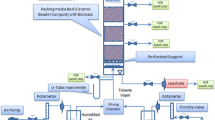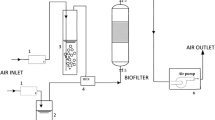Abstract
A bacterial consortium with complementary metabolic capabilities was formulated and specific removal rates were 0.14, 0.35, 0.04, and 0.39 h−1 for benzene, toluene, o-xylene, and m,p-xylene, respectively. When immobilized on a porous peat moss biofilter, removal of all five (= BTX) components was observed with rates of 1.8–15.4 g m−3 filter bed h−1. Elimination capacities with respect to the inlet gas concentrations of BTX and airflow rates showed diffusive regimes in the tested concentration range of (0.1–5.3 g m−3) and airflow (0.55–1.82 m3 m−2 h−1) except for o-xylene which reached its critical gas concentration at 0.3 g m−3.
Similar content being viewed by others
References
Barbieri P, Palladino L, Di Gennaro P, Galli E (1993) Alternative pathways for o-xylene or m-xylene and p-xylene degradation in a Pseudomonas stutzeri strain. Biodegradation 4: 71–80.
Bibeau L, Kiared K, Leroux A, Brzezinski R, Viel G, Heitz M (1997) Biological purification of exhaust air containing toluene vapor in a filter-bed reactor. Can. J. Chem. Eng. 75: 921–929.
Devinny, JS, Medina VF, Hodge DS (1994) Biofiltration for treatment of gasoline vapors. In: Hinchee RE, Atteman BC, Hoeppel RE, Miller RN, eds. Hydrocarbon Bioremediation. Boca Raton, FL: CRC Press, pp. 12–19.
Diks RMM, Ottengraf SPP (1991) Verification studies of a simplified model for the removal of dichloromethane from waste gases using a biological trickling filter, Part II. Bioprocess Eng. 6: 131–140.
Di Lecce C, Accarino M, Bolognese F, Galli E, Barbieri P (1997) Isolation and metabolic characterization of a Pseudomonas stutzeri mutant able to grow on the three isomers of xylene. Appl. Environ. Microbiol. 63: 3279–3281.
Findlay GE, Nirmalakhandan N (1999) Modeling an airlift bioscrubber for removal of airphase BTEX. J. Environ. Eng. 125: 1062–1070.
Kleinheinz GT, Bagley ST (1998) Biofiltration for the removal and detoxification of a complex mixture of volatile organic compounds. J. Ind. Microbiol. Biotechnol. 20: 101–108.
Lee JY, Jung KH, Choi SH, Kim HS (1995) Combination of the tod and the tol pathways in redesigning a metabolic route of Pseudomonas putida for the mineralization of a benzene, toluene, and p-xylene mixture. Appl. Environ. Microbiol. 61: 2211–2217.
Mallakin A, Ward OP (1996) Degradation of BTEX compounds in liquid media and in peat biofilters. J. Ind. Microbiol. 16: 309–318.
Oh YS, Choi SC (1997) Characterization of BTX-degrading bacteria and identification of substrate interactions during their degradation. J. Microbiol. 35: 193–199.
Oh YS, Choi SC (2000) Selection of suitable packing material for biofiltration of toluene, m-and p-xylene vapors. J. Microbiol. 38: 31–35.
Ottengraf SPP (1986) Exhaust gas purification. In: Rehm HJ, Reed G, eds. Biotechnology. Weinheim, Germany: VCH Publishers, pp. 427–452.
Prantera MT, Drozdowicz A, Leite SG, Rosado AS (2002) Degradation of gasoline aromatic hydrocarbons by two N2-fixing soil bacteria. Biotechnol. Lett. 24: 85–89.
Prokop WH, Bohn HL (1985) Soil bed system for control of rendering plant odors. J. Air Pollut. Contr. Assoc. 35: 1332–1338.
Saberiyan AL, Wilson MA, Roe EO, Andrilneas JS, Esler CT, Kise GH, Reith PE (1994) Removal of gasoline VOC via air biofiltration: a technique for treating secondary air emissions from vapor extraction and air stripping. In: Hinchee RE, Atteman BC, Hoeppel RE, Miller RN, eds. Hydrocarbon Bioremediation. Boca Raton, FL: CRC Press, pp. 1–11.
Shareefdeen A, Baltzis BC, Oh YS, Bartha R (1993) Biofiltration of methanol vapor. Biotechnol. Bioeng. 41: 512–524.
Smith MR (1994) The physiology of aromatic hydrocarbon degrading bacteria. In: Ratledge C, ed. Biochemistry of Microbial Degradation. Dordrecht: Kluwer Academic Publishers, pp. 347–378.
Wubbolts MG, Reuvekamp P, Witholt B (1994) TOL plasmid specified xylene oxygenase is a wide substrate range monooxygenase capable of oleofin epoxidation. Enz. Microbiol. Technol. 16: 608–615.
Yeom SH, Yoo YJ (1999) Removal of benzene in a hybrid bioreactor. Process Biochem. 34: 281–288.
Author information
Authors and Affiliations
Rights and permissions
About this article
Cite this article
Choi, SC., Oh, YS. Simultaneous removal of benzene, toluene and xylenes mixture by a constructed microbial consortium during biofiltration. Biotechnology Letters 24, 1269–1275 (2002). https://doi.org/10.1023/A:1016273828254
Issue Date:
DOI: https://doi.org/10.1023/A:1016273828254




